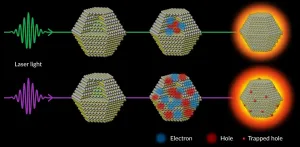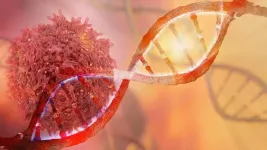The 'great leveler' revisited: Why the Corona pandemic might boost inequality in society
2021-03-25
(Press-News.org) A study by prof. Bas van Bavel and prof. Marten Scheffer shows that throughout history, most disasters and pandemics have boosted inequality instead of levelling it. Whether such disastrous events function as levellers or not, depends on the distribution of economic wealth and political leverage within a society at the moment of crisis. Their findings on the historical effects of crises on equality in societies are now published open access in Nature HSS Communications.
It is often thought that the main levellers of inequality in societies were natural disasters such as epidemics or earthquakes, and social turmoil such as wars and revolutions. The most salient example is the Black Death of 1347-1352, a large-scale pandemic that killed up to half of the Eurasian population. In several European societies, wealth disparities seem to have been reduced afterwards. The suggested logic behind that equitable effect is the decimation of people while capital remained intact, thereby shifting the economic balance in favour of labour. Crises as windows of opportunity In most cases throughout history, the opposite is true. Bas van Bavel: "In spite of the marked differences in character and direct impact of the shocks we studied, most historical disasters were followed by a widening of wealth gaps." In their article, historian Bas van Bavel (Utrecht University) and ecologist Marten Scheffer (Wageningen University) critically review evidence of the effects of catastrophes such as the plague on inequality, from medieval times till the present. Van Bavel and Scheffer used empirical data to study the long term effects of shocks on inequality.
Their research shows a twofold effect. First, the wealth distribution and institutional outlay of these societies at the moment of the shock to a large extent shaped the impact. Subsequently, the distribution of political leverage in society came into play in determining the institutional responses. Van Bavel explains: "Upon a crisis, rules tend to be rewritten. Social groups and organizations with the greatest leverage can therefore use that window of opportunity to adapt institutional rules, thereby shaping long-term wealth distribution. As most societies were historically unequal, in most cases the result was a further widening of disparities."
Power to the people: the importance of bottom-up organisations Over the centuries, exceptions have occurred in situations where the ordinary people had strong leverage in shaping the response to the crisis - through organizations such as guilds, fraternities, trade unions, cooperatives, and political movements. Scheffer: "Our results provide empirical support for the view that in nations where such leverage of ordinary people is weak, the responses to novel crises such as the COVID-19 pandemic may increase inequality instead of diminishing it. Furthermore, when explaining the effects of a disaster on equality, we need to distinguish between the immediate impact, the medium-term effects of the institutional measures taken in response to the disaster, and the indirect outcomes in the long run."
What history suggests about the current pandemic Their insights also hold relevance when thinking about the effects of the COVID 19-crisis. Van Bavel: "The direct impact and long term effects are likely to enlarge material inequalities. The social and economic context at present is much more similar to that during the 2008 crisis than to the context during the twentieth-century disasters - when societies were more equitable both in wealth distribution and societal leverage than at present."
INFORMATION:
The article 'Historical effects of shocks on inequality: the great leveler revisited' is published open access and is now available online: http://www.nature.com/articles/s41599-021-00763-4.
ELSE PRESS RELEASES FROM THIS DATE:
2021-03-25
CHAMPAIGN, Ill. -- Materials that contain special polymer molecules may someday be able to warn us when they are about to fail, researchers said. Engineers at the University of Illinois Urbana-Champaign have improved their previously developed force-sensitive molecules, called mechanophores, to produce reversible, rapid and vibrant color change when a force is applied.
The new study led by postdoctoral researcher Hai Qian, materials science and engineering professor and head Nancy Sottos, and Beckman Institute of Advanced Science and Technology director Jeffrey Moore is published in the journal Chem.
Moore's team has been working with mechanophores for more than a decade, but past efforts have produced molecules that were slow to react and return to their original state, if at all. ...
2021-03-25
Bright semiconductor nanocrystals known as quantum dots give QLED TV screens their vibrant colors. But attempts to increase the intensity of that light generate heat instead, reducing the dots' light-producing efficiency.
A new study explains why, and the results have broad implications for developing future quantum and photonics technologies where light replaces electrons in computers and fluids in refrigerators, for example.
In a QLED TV screen, dots absorb blue light and turn it into green or red. At the low energies where TV screens operate, this conversion of light from one color to another is virtually 100% efficient. But at the higher excitation energies required for brighter screens and other ...
2021-03-25
In the year since the coronavirus pandemic upended how just about every person on the planet interacts with one another, video conferencing has become the de facto tool for group collaboration within many organizations. The prevalent assumption is that technology that helps to mimic face-to-face interactions via a video camera will be most effective in achieving the same results, yet there's little data to actually back up this presumption. Now, a new study challenges this assumption and suggests that non-visual communication methods that better synchronize and boost audio cues are in fact more effective.
Synchrony Promotes Collective Intelligence
Researchers from Carnegie Mellon's Tepper School of Business and the Department of Communication at the University of California, Santa ...
2021-03-25
Despite having remarkable utility in treating movement disorders such as Parkinson's disease, deep brain stimulation (DBS) has confounded researchers, with a general lack of understanding of why it works at some frequencies and does not at others. Now a University of Houston biomedical engineer is presenting evidence in Nature Communications Biology that electrical stimulation of the brain at higher frequencies (>100Hz) induces resonating waveforms which can successfully recalibrate dysfunctional circuits causing movement symptoms.
"We investigated the modulations in local ?eld potentials induced by electrical stimulation of the subthalamic nucleus (STN) at therapeutic and non-therapeutic frequencies in Parkinson's disease patients ...
2021-03-25
LA JOLLA--The glow of a panther's eyes in the darkness. The zig-zagging of a shark's dorsal fin above the water.
Humans are always scanning the world for threats. We want the chance to react, to move, to call for help, before danger strikes. Our cells do the same thing.
The innate immune system is the body's early alert system. It scans cells constantly for signs that a pathogen or dangerous mutation could cause disease. And what does it like to look for? Misplaced genetic material.
The building blocks of DNA, called nucleic acids, are supposed to be hidden away in the cell nucleus. Diseases can change that. Viruses churn out genetic material in parts of the cell where it's not supposed to be. Cancer cells do too.
"Cancer cells harbor damaged DNA," says ...
2021-03-25
New clues to a long-pursued drug target in cancer may reside within immune cells, researchers at the University of Michigan Rogel Cancer Center have discovered.
The findings, which appear in Nature Immunology, not only shed new light on cancer immunology, they also suggest clinical trials related to this key target -- an interaction that destabilizes the important p53 tumor suppressor protein -- may unnecessarily be excluding a large number of patients.
The researchers are optimistic that the findings could help make immunotherapy treatment more effective against ...
2021-03-25
CORVALLIS, Ore. - Warm river habitats appear to play a larger than expected role supporting the survival of cold-water fish, such as salmon and trout, a new Oregon State University-led study published today found.
The research has important implications for fish conservation strategies. A common goal among scientists and policymakers is to identify and prioritize habitat for cold-water fish that remains suitably cool during the summer, especially as the climate warms.
This implicitly devalues areas that are seasonally warm, even if they are suitable for fish most of the year, said Jonny Armstrong, lead author of the paper and an ecologist at Oregon State. He called this a "potentially severe blind spot for climate change adaptation."
"Coldwater ...
2021-03-25
Lithium-ion batteries have made possible the lightweight electronic devices whose portability we now take for granted, as well as the rapid expansion of electric vehicle production. But researchers around the world are continuing to push limits to achieve ever-greater energy densities -- the amount of energy that can be stored in a given mass of material -- in order to improve the performance of existing devices and potentially enable new applications such as long-range drones and robots.
One promising approach is the use of metal electrodes in place of the conventional graphite, with a higher charging ...
2021-03-25
Many psychiatric disorders have genetic causes, but the exact mechanism of how genes influence higher brain function remains a mystery. A new study provides a map linking the genetic signature of functions across the human brain, a tool that may provide new targets for future treatments.
Led by Bratislav Misic, a researcher at The Neuro (Montreal Neurological Institute-Hospital) of McGill University, a group of scientists performed machine learning analysis of two Open Science datasets: the gene expression atlas from the Allen Human Brain Atlas and the functional ...
2021-03-25
DURHAM, N.C. - Engineers at Duke University have developed an electronics-free, entirely soft robot shaped like a dragonfly that can skim across water and react to environmental conditions such as pH, temperature or the presence of oil. The proof-of-principle demonstration could be the precursor to more advanced, autonomous, long-range environmental sentinels for monitoring a wide range of potential telltale signs of problems.
The soft robot is described online March 25 in the journal Advanced Intelligent Systems.
Soft robots are a growing trend in the industry due to their versatility. Soft parts can handle delicate objects such as biological tissues that metal or ceramic components would damage. Soft bodies can help robots float or squeeze into tight spaces where rigid ...
LAST 30 PRESS RELEASES:
[Press-News.org] The 'great leveler' revisited: Why the Corona pandemic might boost inequality in society





